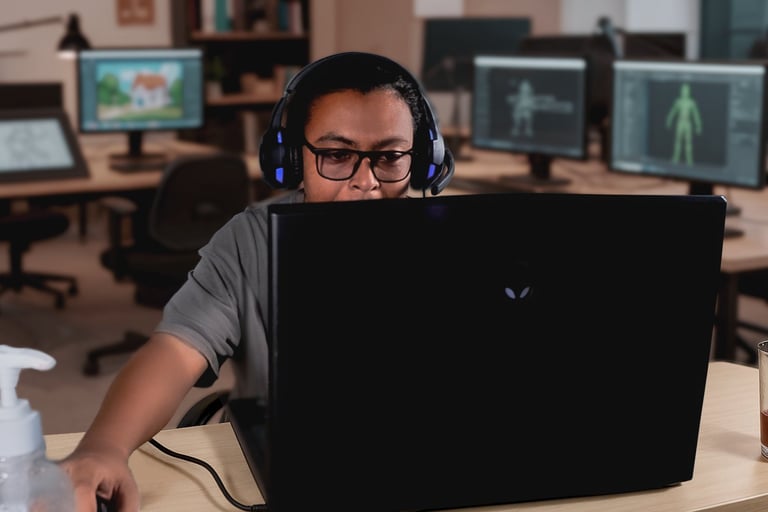Frequently Asked Questions (FAQ) - Animation and Motion Design
1. What's the difference between 2D and 3D animation?
2D animation relies on images drawn in two dimensions and animated frame by frame to create movement. It's often used for cartoons, commercials or instructional videos.
3D animation, on the other hand, uses three-dimensional models created in specialized software. It offers greater depth and realism, and is commonly used in films, video games and high-end advertising.
2. What's the difference between animation and motion design?
Animation refers to any type of visual creation in motion, whether 2D or 3D.
Motion design is a specific branch of animation that focuses on animated graphics. It is often used for instructional videos, film credits, digital interfaces and animated advertising.
3. What are the stages involved in creating an animated video?
Creating an animated video involves several stages :
Brief and concept : defining objectives and the message to be conveyed.
Storyboard and script : creation of a scenario and initial visual sketches.
Design and illustrations : creation of the graphic elements that will make up the animation.
Animation : setting the elements in motion while respecting the desired rhythm.
Sound and post-production : adding voices, music and sound effects to finalize the video.
4. How long does it take to complete a 2D/3D animation project?
Production time depends on several factors : the complexity of the project, the length of the video and the style of animation.
A simple 2D animation can take between 2 and 6 weeks.
A more complex 3D animation can take several months to complete.
5. What is an animation studio?
An animation studio is a company specializing in the production of animated content, whether 2D or 3D. It brings together several professionals: scriptwriters, illustrators, animators, editors and sound engineers, who work together to create films, commercials, music videos, video games or educational content.
6. What are the jobs in animation?
The jobs in animation are varied and include :
2D/3D animator: responsible for animating characters and objects.
Storyboarder: creates the visual scenario in storyboard form.
3D modeler: designs the 3D models used in films and video games.
Computer graphics designer: takes care of graphic design and textures.
Animation director: oversees the project from start to finish.
Sound engineer: handles sound and sound effects for animation.
7. What are the advantages and disadvantages of 2D animation?
Advantages :
Unique, expressive artistic style.
Less expensive and faster to produce than 3D.
Ideal for cartoons and instructional videos.
Disadvantages :
Less realism than 3D.
Requires a lot of manual work frame by frame.
Limited for certain perspectives and special effects.
8. What are the advantages and disadvantages of 3D animation?
Advantages :
More realistic and immersive visual effects.
Easy reuse of models and animations.
Possibility of integrating advanced special effects.
Disadvantages :
Longer production times.
Higher cost due to software and complexity.
Advanced technical skills required.
9. Who is the animation designed for?
The animation is designed for a variety of audiences, including :
Companies and brands : for advertising and instructional videos.
Film and TV studios : for the creation of animated films and series.
Education and e-learning : for interactive educational content.
Independent creators : for artistic and narrative projects.
10. Why animate?
Animation is a captivating and dynamic way of telling stories. It is used to :
Explain complex concepts in a visually accessible way.
Create a unique and engaging universe for entertainment.
Reinforce the impact of an advertising or educational message.
Bring creative ideas to life without physical limits.
11. Why do we need motion design?
Motion design is essential for many reasons, whether in communications, marketing, education or entertainment. Here's why it's so important :
Grab attention quickly :
In a world saturated with information, motion design immediately catches the eye with fluid animations and dynamic visuals.
Simplifies complex messages :
Explain complicated concepts clearly and concisely with animated illustrations, diagrams and visual storytelling.
Improves engagement :
Animated content is more interactive and engaging than text or static images, increasing viewing time and message recall.
Reinforces visual identity :
Thanks to customized animations (colors, typography, logos), motion design reinforces the brand and enhances recognition.
Easy to share:
Animated videos are popular on social networks and streaming platforms, facilitating their virality and widespread distribution.
Versatile and adaptable :
It can be used in a variety of contexts: commercials, explainer videos, e-learning, corporate presentations, UX/UI, etc.
Optimized for digital :
With the rise of digital marketing, motion design fits perfectly into web strategies (sites, ads, Instagram stories, YouTube, etc.).
12. What's a hybrid 2D and 3D animation?
Hybrid 2D and 3D animation is a technique that combines two-dimensional (2D) and three-dimensional (3D) elements in the same production. This approach allows you to benefit from the advantages of each style to create unique and original visual effects.
Why use this technique?
Unique aesthetics: The result is a more expressive and original visual experience.
Flexibility and fluidity: 3D animation facilitates camera movements and consistency of perspective, while 2D allows for more expressive stylization.
Cost reduction: Some studios choose to mix the two techniques to optimize their budget and production time.
13. What is 3D modeling?
3D modeling is the process of creating an object or character in three dimensions (width, height, depth) using specialized software. This technique is used in animation, video games, film, architecture, industrial design and many other fields.





